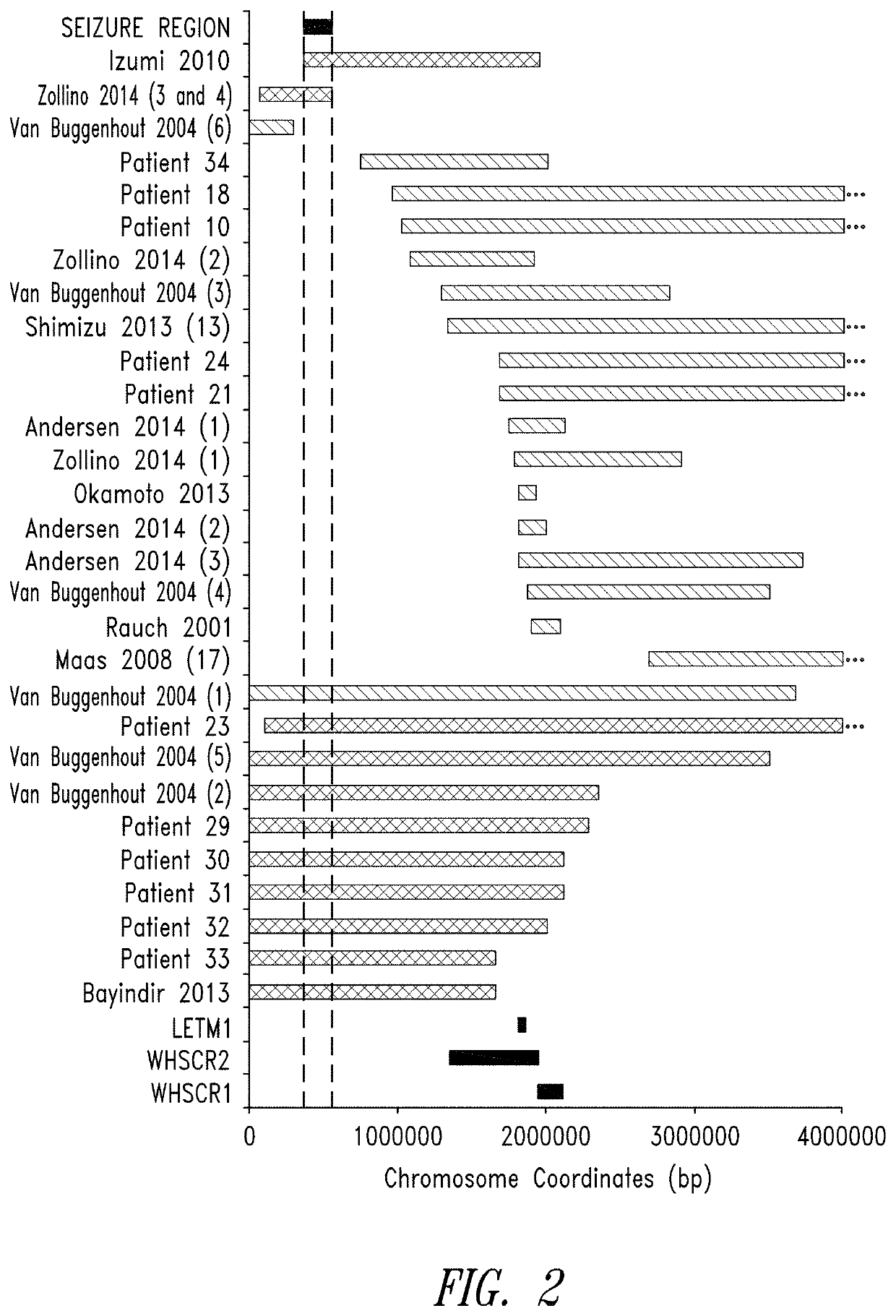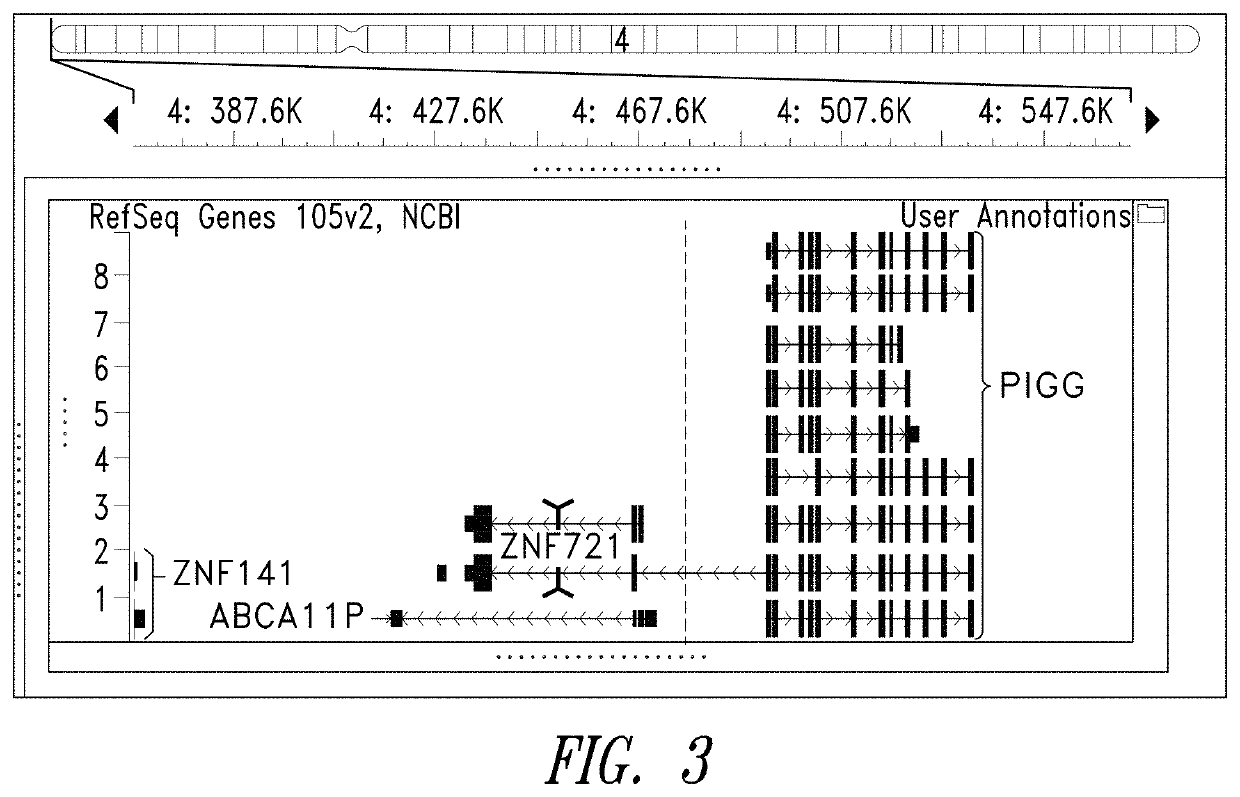Identification of seizure susceptibility region in wolf-hirschhorn syndrome and treatment thereof
a gene for wolfhirschhorn syndrome and a susceptibility region, applied in the field of gene markers for wolfhirschhorn syndrome, can solve the problems of limited success in genotype-phenotype correlation studies of whs patients, significant impact on quality of life, etc., and achieve the effect of reducing the frequency of seizures
- Summary
- Abstract
- Description
- Claims
- Application Information
AI Technical Summary
Benefits of technology
Problems solved by technology
Method used
Image
Examples
example 1
Identification of a 4P Terminal Region Associated with Seizures in Wolf-Hirschhorn Syndrome
[0150]Wolf-Hirschhorn syndrome (WHS) is a contiguous gene deletion syndrome involving variable size deletions of the 4p16.3 region. Seizures are frequently, but not always, associated with WHS. In order to determine if the size and location of the deleted region correlates with seizure presentation, chromosomal microarray analysis (CMA) was used to finely map the breakpoints of copy number variants (CNVs) in 48 individuals with WHS. Seizure phenotype data were collected through parent-reported answers to a comprehensive questionnaire and supplemented with available medical records.
[0151]Because WHS is a contiguous gene deletion syndrome, loss of one copy of a single gene or the synergistic effects of loss of two or more genes could give rise to the features of WHS. One such gene, LETM1, falls within WHSCR2 and has been proposed as a candidate seizure gene (Endele et al. Genomics 1999; 60:218-2...
example 2
The Effect of PIGG Insufficiency on Seizures
[0176]The identification of the relatively small candidate seizure region now affords the opportunity to create loss-of-function knockouts of candidate genes in model organisms to confirm that haploinsufficiency of such genes is sufficient to increase seizure susceptibility and also to perform functional studies that will further elucidate the mechanism of these genes' functions in health and disease. Using such an approach, precision medicine for complex genetic disorders such as contiguous gene disorders becomes possible.
[0177]The 197 kbp seizure susceptibility region described in the previous Example encompasses two genes and one pseudogene. ZNF721 encodes a zinc-finger-containing protein of unknown function, PIGG encodes a member of the phosphatidylinositol glycan anchor biosynthetic pathway and ABCA11P is a pseudogene with sequence similarity to ATP-binding cassette, subfamily A. While not much is known about the biological function o...
example 3
Treating WHS Seizures with Cannabidiol
[0181]The availability of chromosomal microarray analysis (CMA) has led to evolution of our understanding of the genomic variation within WHS and its correlation with phenotype (Maas et al., 2008; Battaglia et al., 2015; South et al., 2008). Recently, we described a novel candidate region for the seizures associated with WHS (Ho et al., 2016). The most plausible candidate gene in the region, PIGG, encodes an enzyme responsible for one step in a biosynthetic pathway that assembles and attaches a phosphatidylinositol glycan (GPI) anchor to over 150 separate proteins in order to direct them to the outer leaflet of the plasma membrane where they carry out various signaling and extracellular functions (Kinoshita, 2014). Deficiencies in GPI anchor synthesis, including those caused by variants in PIGG, underlie congenital disorders of glycosylation, which are associated with infantile encephalopathy, ID, and / or seizures (Makrythanasis et al., 2016).
[01...
PUM
 Login to View More
Login to View More Abstract
Description
Claims
Application Information
 Login to View More
Login to View More - R&D
- Intellectual Property
- Life Sciences
- Materials
- Tech Scout
- Unparalleled Data Quality
- Higher Quality Content
- 60% Fewer Hallucinations
Browse by: Latest US Patents, China's latest patents, Technical Efficacy Thesaurus, Application Domain, Technology Topic, Popular Technical Reports.
© 2025 PatSnap. All rights reserved.Legal|Privacy policy|Modern Slavery Act Transparency Statement|Sitemap|About US| Contact US: help@patsnap.com



